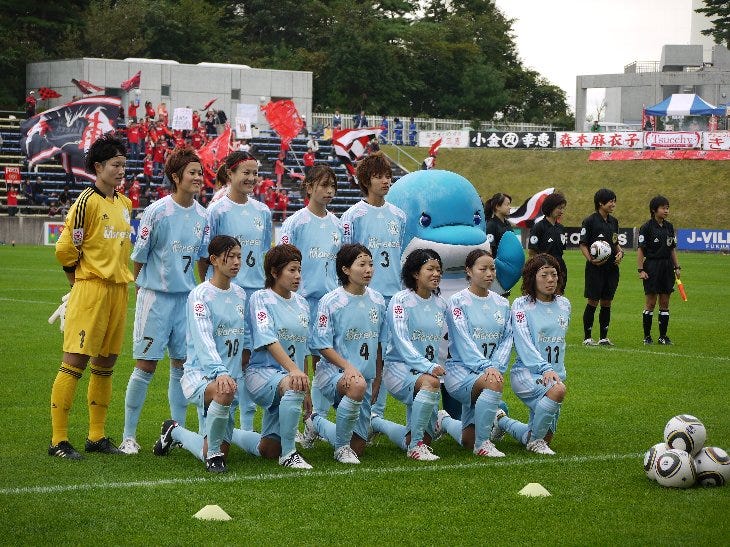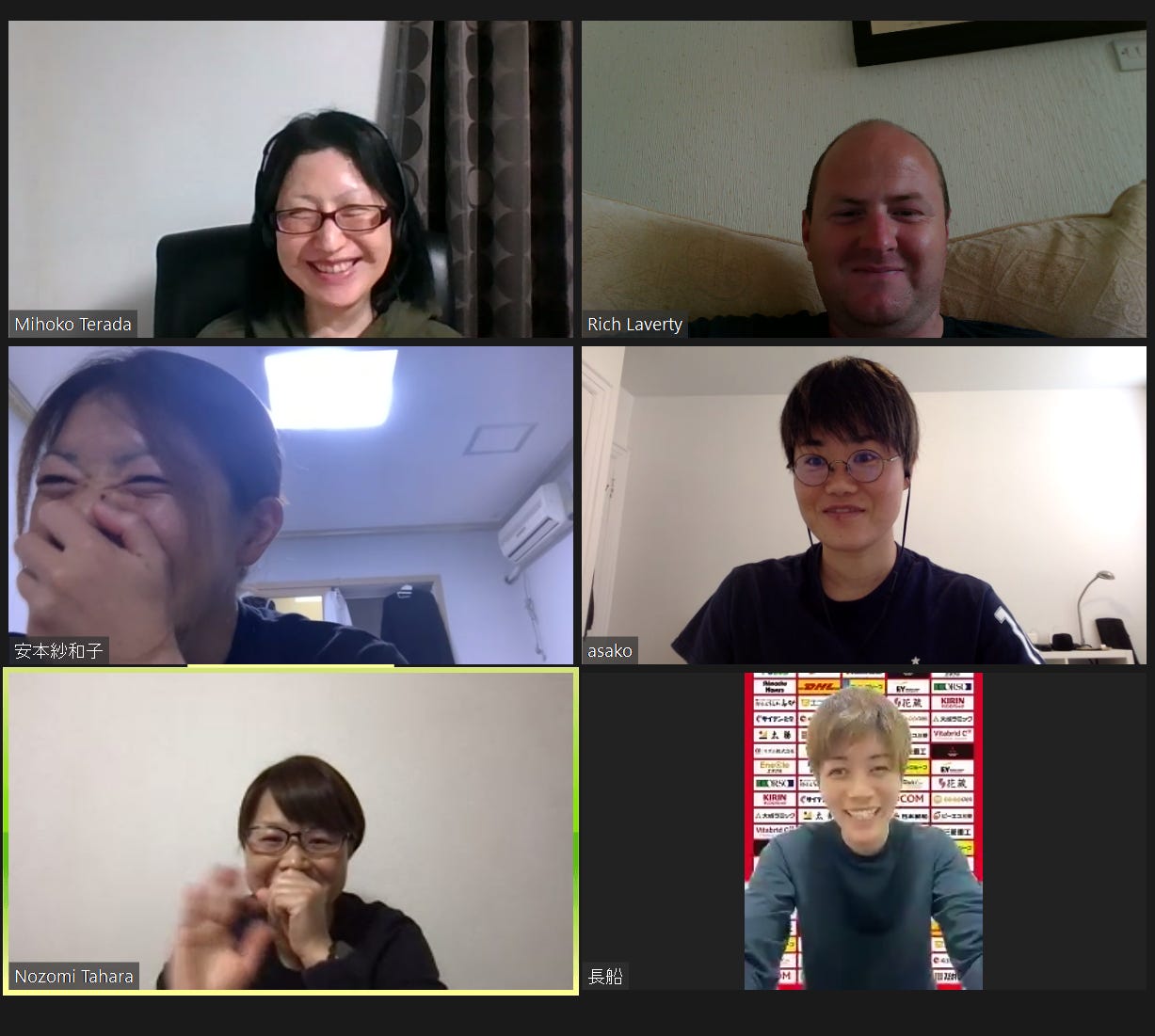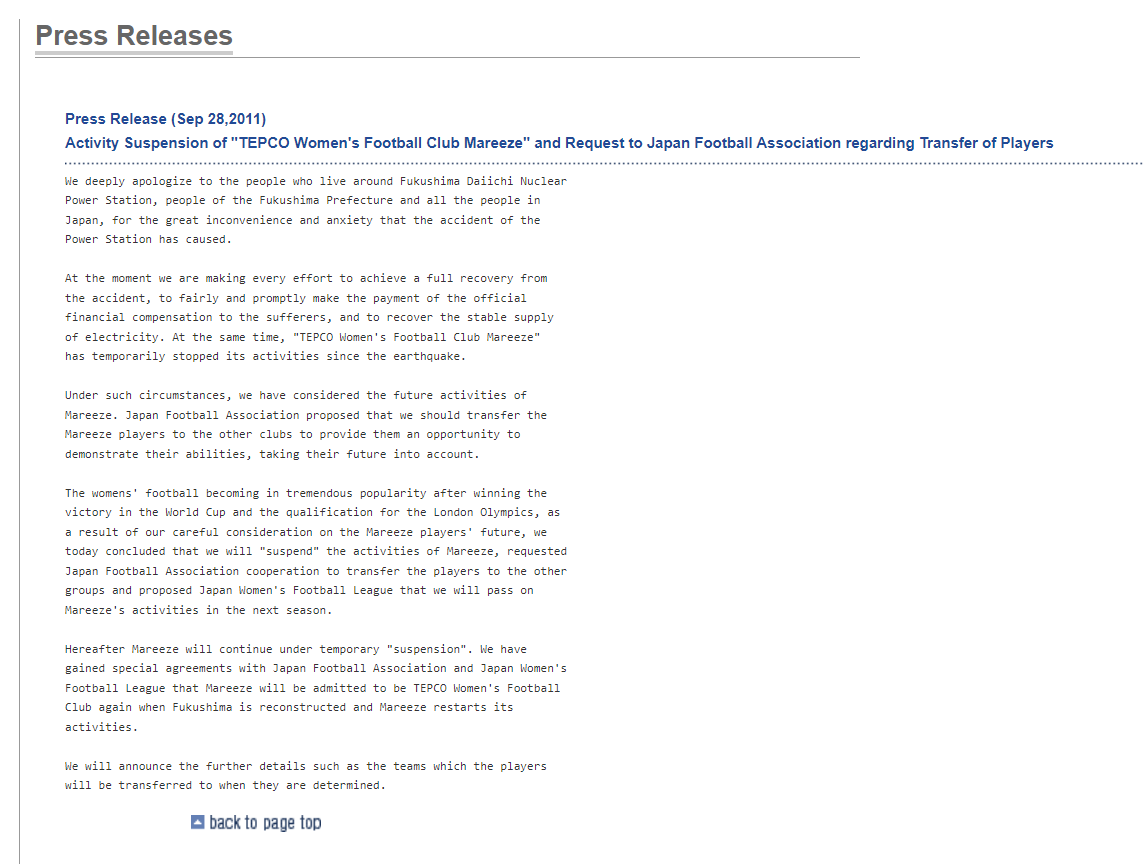How an entire football club was lost to the 2011 Japan earthquake
TEPCO Mareeze were challengers at the top of the Nadeshiko League going into 2011, but the tragic earthquake and subsequent tsunami wiped the club off the map.
Japan winning the 2011 Women’s World Cup wasn’t just a great story for the fact it was considered a huge shock around the world.
They had not bypassed the group stage on any of their previous three attempts and had only once reached the quarter-finals, so their penalty shoot-out victory over previous champions USA was a huge moment for the country.
But the background it was set on is both astonishing as it is emotional. Four months earlier, the whole nation entered a state of disaster when an earthquake hit 45 miles away from the eastern coastline, lasting six minutes.
The after effects were horrendous. It was the most powerful earthquake to hit Japan and the fourth most powerful ever recorded anywhere in the world, leading to the tragic deaths of almost 20,000 people.
But it didn’t end there. The underwater earthquake subsequently caused a tsunami which hit the Tōhoku Region, where the Fukushima Daiichi nuclear plant was stationed.
The flooding of three of its main generators eventually led to a catastrophic explosion and the most significant nuclear accident since Chernobyl in the 1980s.
The release of radioactive substance saw everyone within a 12-mile radius evacuated – over 100,000 people – and took further toll on the Japanese public.
But the disaster also took away one of Japan’s leading women’s football teams – TEPCO Mareeze.
“A fire engine came to the field and told us we have to stop playing and get to a high place, as high as we could…”
TEPCO (Tokyo Electric Power Company) is the largest energy provider in Japan and like many of its rivals decided to invest in the women’s game at the time, taking over the previous team based in Tōhoku at the time in 2005.
After being relegated in 2006, they returned at the first time of asking and were on an upward spiral heading into the 2011 season after back-to-back third place finishes in 2009 and 2010.
TEPCO had purchased established Japanese internationals such as Aya Sameshima and looked serious about going a step further heading into the year of the World Cup. TEPCO ran the nuclear plant and players were subsidised by working for the company at the plant, either as administrative assistants or in public relations.
The players worked from 8am to Midday before training in the afternoon at the state of the art J-Village, just a few miles from the nuclear plant.
The disaster eventually led to the club disbanding operations in September that year, with players unable to return to the area due to the radiation.
They lost their jobs, their homes and their football club, and now several of them tell their story, 12 years on.
The good news was the team was on a camp in the south of Japan at the time, and they are all aware of how much worse it could have been had timing not been on their side.
“We were in Miyazaki having a pre-season camp,” says Asako Ideue, now based in New York after pursuing a playing career in the USA. “The day it happened, we were training. A fire engine came to the field and told us we have to stop playing and get to a high place, as high as we could because a huge earthquake occurred in eastern Japan and a tsunami warning had been announced.
“We went back to the hotel and stayed on the second floor. There was a TV in the room and once we turned it on we realised what was going on and it was very severe. While I was watching, I just couldn’t believe it.”
Sawako Yasumoto, another member of the TEPCO Mareeze squad that year and who still plays in South Korea, continues the story.
“Miyazaki was an ocean area on the coast, so we had to be evacuated or get to a high area. We watched it unfold on TV.
“The phone line was down. I remember trying to call people but we couldn’t reach them. We tried to find a pay phone, we didn’t even have our mobiles with us because we had to come straight upstairs from the pitch. I remember I managed to contact my parents to find out they were ok, but it was very difficult for a lot of people trying to find out what was coming on.”
Losing their jobs, players were transferred to various branches. Most went to the Kanto region, whereas Yasumoto was transferred to the Chiba branch after joining JEF United Chiba for the remainder of 2011.
Check out over 100 more unique stories in WFC’s Premium section, available for just £45 for 12 months, paid in one go, or a £6 a month rolling subscription.
All subscriptions come with a 7-day free trial to allow you to explore our full archive.
Plus, guarantee you everything that is to come over the next 12 months…
The emotion took its toll on many who didn’t even know if they wanted to continue playing as TEPCO and the Nadeshiko League looked for a resolution as what would happen to the players looking for a new club.
“We only came to TEPCO to play football,” says Nozomi Tahara, another member of the team. “We were in two minds if it was ok to keep playing football. It was hard to know if we should carry on, it was wealthy to play football, but other people were losing their jobs, their houses and some their lives.
“We couldn’t go home, it was too close to the main plant, so we were not allowed home for the first six months. Everything we had was there, and even when we went back it was only a temporary visit to pick up our things.”
Kana Osafune, who also still plays in Japan for Urawa Reds and was a Japan senior international, admits she was “not very ok emotionally” and hasn’t forgotten the feeling of losing the team and the friends she made.
“I prayed for six months,” she says. “I always remembered TEPCO, my team, my friends. We shared a lot of memories, but it is not really something we have talked a lot about since. It was a sad time, but we are fortunate we were ok. We are alive and we still have our careers and our jobs.”
The J-Village had become a relief centre. Temporary tents lined the pitch which was covered in sand, dust and rubble, and wasn’t restored until 2019 when it was used as the starting point for the Tokyo Olympic Games torch relay.
Across the pond, Boston Breakers player Claire Zimmeck was also eagerly trying to find out what was going on. US and Japanese teams were playing regular friendlies around that time and TEPCO had played FC Gold Pride a year previous, with Breakers player Zimmeck and team mate Taryn Hemmings spending three weeks training with the team in Japan, with an eye to several TEPCO players doing the same in Boston.
They left less than a fortnight before the earthquake, and Zimmeck recalls the feeling of trying to find out what was happening to “the most welcoming people ever” as news spread across the globe of the disaster.
“It was basically Tony DiCicco’s [Breakers head coach at the time] brainchild,” says Zimmeck. “We went out there to train, get fit, work on our skills and get ready for the season with the Breakers. We stayed out there for a few weeks. We did two weeks at J-Village and then a week’s camp in Chiba.
“They were all in another camp, I remember emailing them because I didn’t have numbers…”
“All I have are fond memories. It was hard, but when I say hard I mean in that they work their butts off. It was definitely a good place to go and get fit. You couldn’t hold the ball more than a second, you either lose the ball or you get taken out. I remember being in a sand pit with straps around my waist trying to run, it was just a challenge.”
Zimmeck and Hemmings immediately felt at home. She says they “felt comfortable all the time” and befriended TEPCO player Lisa Yamamoto, who spoke good English, who took them to Tokyo for a weekend of sightseeing with her brother.
She admits it was “very scary” to think how close the earthquake was to their departure back to the USA as she recalls trying to get in touch to see if they were safe.
“It was so close in timing. They were all in another camp, I remember emailing them because I didn’t have numbers.
“They couldn’t go back home for so long. They had to leave their cars, their homes, all their stuff. There was no social media, I only ever connected via email. I still have emails from them that year, I saved them all. I think it was 11 days before the tsunami I came home, I emailed them all the day after to try and find out if they were ok.”
For one player in particular, the uncertainty of not having a team to play for was particularly stressful.
Sameshima was very likely to make up a key part of Japan’s squad that summer, but faced the prospect of several months without competitive football as the Japanese FA worked out what would happen to the contracts the players had with TEPCO before the subsequent disbanding in September.
That’s when the club’s link with the Breakers came in, and Sameshima headed stateside to be reunited with Zimmeck and play her football in the USA, becoming the first TEPCO player to find a new club. In June, she made her debut, replacing England international Alex Scott in defence.
“Aya needed to find a team to keep playing,” recalls Ideue. “It was very difficult for her to leave the team and the company, but she played for the national team and they became world champions. We were very moved with the result, it meant a lot to everyone.”
It was Zimmeck who had recommended a move to the Breakers to Sameshima, and the two became close friends during her few months with the club before she joined French side Montpellier.
“She stayed with a Japanese family when she was here and I’d go and pick her up and take her to training and what not. She came and stayed with me a few years ago, hung out with my friends, we had some close relationships come out of that.
“When Aya came over, I treated her like they treated me. I tried to be as welcoming and helpful as possible, it was just very tragic because they were all such nice people. I tried to take care of her when she was here. She had no family here, didn’t drive, didn’t really speak the language. She’s uber famous in Japan, if they’d known she was here I think they’d have hunted her down! I have such fond memories, I wish we’d all had social media because it would have been a lot easier to stay in touch.”
When the World Cup came around, the story unfolded like a fairy tale. Japan beat Germany in the quarter-finals, Sweden in the semi-finals and when all looked lost with just four minutes of extra-time remaining in the final, captain Homare Sawa rose to take the game to penalties, which Japan subsequently won.
With the backdrop of the disaster combined with a lack of support at the time from the JFA, the team received worldwide acclaim for their achievement. Such was the scale of the tragedy, it was uncertain for a while as to whether they would even compete, let alone go all the way.
“To keep going and show what sport can do, that it has the power to encourage people and make people better…”
Back home in Japan, amidst daily barrages of more deaths and the constant reminder of the gloom set across the nation’s mood, their victory lifted a whole nation.
Masaaki Kanno, the TEPCO head coach, sent Sameshima a letter before the tournament expressing his belief in her ability to put aside her emotion to help her team, while Japan head coach Norio Sasaki used images of the disaster to inspire his team to play for the hearts of the nation before their quarter-final against Germany.
Some were so upsetting that Sameshima and others could barely look at them.
“To watch Japan win like that really encouraged me to keep playing,” says Osafune. “To keep going and show what sport can do, that it has the power to encourage people and make people better.”
Zimmeck, who was watching back home, admits if the USA couldn’t win it she was delighted it was Japan who beat her nation.
“It was amazing,” she smiles. “I’m USA, but Japan’s always my second team. It’s hard to know who I was rooting for at the time. Aya came back and gave me her jersey, I still have it, the jersey she won the World Cup with.
“She said ‘Zimm, I couldn’t have done this without you’, which is not true at all! She was intense, she’d spend hours at the Breakers training ground doing her own extra stuff, she was amazing. They definitely deserved it, they were a tough group of girls.”
Understandably, like many others, Sameshima said it was “so hard to speak about Mareeze” when reached out to for this feature, but appreciated what her friend and former teammate had to say.
“I love my old team and spent amazing times there, so I remember the good times, but it brings back sad memories because of the earthquake. I really miss Claire, I hope she’s doing well,” she said in a message.
In Japan, the fallout continued, as the death toll rose, the blame for the disaster started to fall on TEPCO themselves and an investigation set up by Japan’s parliament blamed the energy company for failing to meet safety requirements or to plan for such an event.
Just last year, four former TEPCO executives were ordered by a Tokyo court to pay a 80 billion pound fine over the disaster.
Some former players still remain there. Ayako Masuda, a former goalkeeper, had retired from playing and was working in public relations when the disaster happened, and was one of the 110,000 who had to evacuate.
She was caught up in the fallout as TEPCO took the brunt of the blame from the local population, and Masuda still works at the plant to this day, handling the reconstruction of the area.
TEPCO Mareeze was formally disbanded on September 28th, 2011, with most players moving to the newly-created Vegalta Sendai in 2012, a club based not far from where TEPCO had been based.
Some have returned to their former homes, some still haven’t.
“It depends on the person, but I think most of us returned two or three times,” says Ideue. “We visited Fukushima Daiichi and went to our team houses to look, to get our cars and our belongings.
“We went to see our co-workers, it was a long time after the tsunami before we saw them again. We were happy to see them, happy to be able to return.”
Only in recent years has life started to return to some kind of normality in Fukushima, but it is said it could take up to 40 years for the reconstruction completely, bringing home the stark reality of one of the world’s worst disasters.








Thank you very much for a meaningful and fair article. I can't say thank you enough. This is definitly what we have to remember.
Mihoko Terada, the former translator at Vegalta Sendai Ladies.